Fight of the colours | PRISMA Offsite September 2023

Intern Customer Success
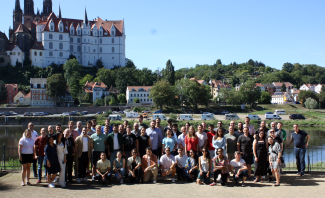
Where do colors meet PRISMAtes? Only at the PRISMA offsite! We engaged in thrilling games in different teams. But that's not all, we delved into a diverse array of different workshop sessions, from brainstorming to creative thinking, gamification, cybersecurity among other things, uncovering valuable insights along the way. If you're curious to learn more, read on!
PRISMAtes, don't forget to fasten your bungee cords!
60 PRISMAtes, 2,5 days, and 3 shared goals: working together, trusting our teammates, and accepting our strengths and weaknesses. This Offsite in Meißen was like none other before: We had an array of enriching workshops, fruitful discussions about PRISMA's future and learnt a lot about ourselves and our colleagues.
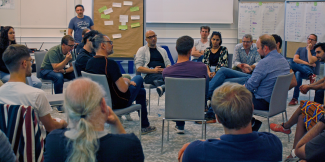
For instance, what it means to find our Ikigai - a sense of purpose and how to visualise our goals and work towards them. We gained insights into methods for creative thinking, gamification, and cybersecurity, among other things.
we also learned a lot about Meißen during a city tour in the beautiful late summer weather and at Schloss Proschwitz, where Princess and Prince von Lippe provided us with an impressive tour and delightful wine tasting.
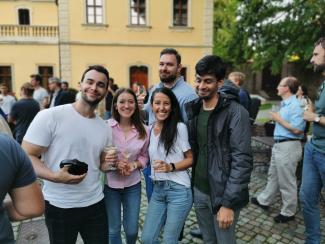
This event was a welcoming change to our daily work and the perfect way to connect to other PRISMAtes on a different level - and that is exactly what we did. Not only with workshops, but also with plenty of fun and games!
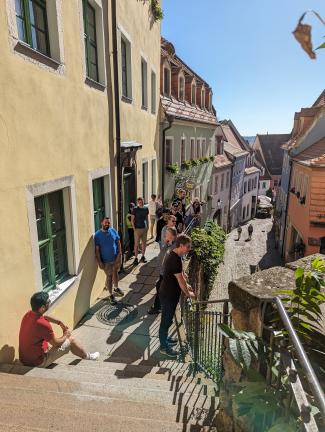
We were assigned to different groups with colorful chocolate bars and had to tackle various challenges. We sparked friendly competitions from balancing on tiny stools to Bungee running, to throwing frisbees and testing our general knowledge and the knowledge of PRISMAs history with a quiz, and let's not forget assembling LEGO cars where only one teammate was allowed to look at the instructions and explain what to do.
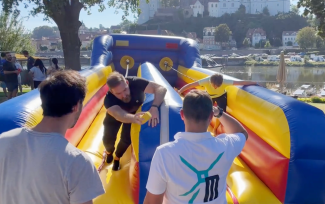
The culmination of the event was an award ceremony where we cheered team black on, who took the first position, but the experience taught us much more than that. We learned that successful teamwork requires everyone to work towards a common goal, to rely on one another, and to have fun throughout the process while having fun and tackling task that typically don't come up in our daily work. These lessons are not only applicable to games but also to our daily work and how we appreciate our colleagues.
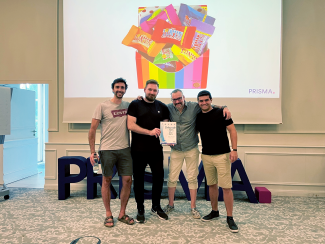
Insights & Learnings
As a hybrid company, we hold a special appreciation for events that bring us all together in person. The PRISMA Offsite was no exception, providing us with a delightful blend of fun in the beautiful city of Meissen. Learning more about each other and building beautiful connections. During this gathering, we were introduced to various methods that enriched our ability to discuss, brainstorm, listen, tap into our creativity, and practice mindfulness. Here, we share a brief overview of the valuable lessons we learned.
The Fishbowl
When has it ever helped a company when employees act like fish? Whenever they have used the Fishbowl method! It can be used to discuss even complex and theoretical topics on which there are many questions or opinions in a short time. At PRISMA our Agile Coach Christian Wanger introduced us to this method on our company offsite. Let's wrap up, how to Fishbowl.
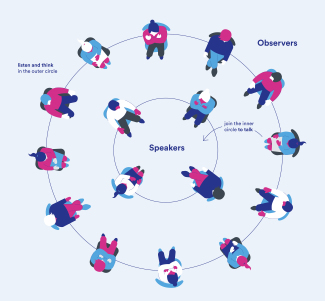
A small group of people (typically 3-5) sit in the centre of a circle and have a discussion or debate on a particular topic. The rest of the participants sit around the circle and listen to the conversation. The inner group is the "fishbowl" group, and they are the only ones who are allowed to speak during the discussion. However, any participant from the outer group can take the place of someone in the inner group.
This approach encourages active listening and focused attention, allowing for a more intentional and inclusive conversation. It also encourages diverse perspectives as more participants can have the opportunity to share their thoughts and ideas. Even an otherwise quiet fish can really revive here. The fishbowl method can be particularly useful when discussing complex or controversial topics, as it allows for a more respectful and open exchange of ideas.During our discussions, we gained fascinating insights into the future development of PRISMA.
We delved into essential questions about the pace and extent of our company's growth, the prospects for new projects, and where our focus should lie as an organization.
The diverse points of view shared during these discussions provided valuable perspectives, offering a well-rounded understanding of the possibilities ahead. We appreciated the richness of ideas that emerged from this approach.
Finding your Ikigai ( 生き甲斐)
Have you ever heard of “Ikigai” and why it matters both personally and professionally?
What sounds like a man you don't want to have anything to do with (icky-guy) is a Japanese concept for finding meaning in life. At our offsite, People & Culture Specialist Mariana Fernandez introduced us to it. Here is a break down of how it works:
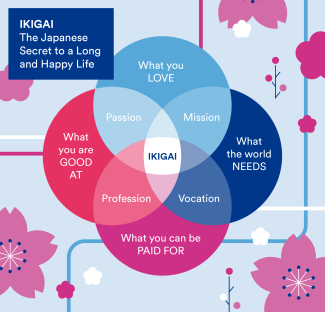
Ikigai is a Japanese concept that combines two words: "iki," which means life, and "gai," which means worth or value. It essentially translates to "a reason for being" or, to put it more simple, "a reason to get out of bed in the morning." According to the Japanese, everyone has an Ikigai; some just haven't found it yet. But how do you start the search to find your inner self?
Five core steps to make Ikigai work:
-
Find what you love doing (your passion).
-
Find what the world needs (your mission).
-
Find out what you're good at (your vocation).
-
Find what you can be paid for (your profession).
-
Find the intersection of the four above and focus all your attention on that.
The idea is that the perfect balance or sweet spot is found where these four elements intersect. It's not necessarily about finding your ultimate passion or career, but rather finding harmony and purpose in the overlap of these areas.
This concept suggests that when what you love and what the world needs intersect, it becomes your mission. What the world needs and what you can be paid for become your vocation. When what you're paid for and what you're good at intersect, this becomes your profession. And when what you're good at and what you love intersect, this becomes your passion.
The Golden Rule: Take it slow!
Enjoy the journey to find yourself; you are not in a race, you are in a marathon. Surround yourself with positivity and the things that give you fulfilment. Follow your Ikigai, discover and unleash it, and find your reason for being!
According to the Japanese, believing in Ikigai is the secret to a long and happy life.
So the next time you feel like you can't find your purpose to get out of bed or in life, try following these five steps to find your Ikigai!
Visualisation and limiting beliefs
Using the power of imagination to visualise manifest and achieve your goals!
One interesting workshop some PRISMAtes attended was the art of visualisation that was presented by Ines Mensah.This is a process where you create images, environments and feelings in your mind even before they have happened, almost like the art of manifestation. It is a very active active and cognital metal practice where we actively rewire the neuons in our brains.

This workshop mainly focused on our imagination, and since we all have different imaginations, it’s all about using it to the best of our abilities. It taught us to believe and trust in our minds. It was also interesting to learn that our mind, as clever as it is or as we think it is, it can not tell what is real and what is imagined. What was way more interesting is that we got an insight of how athletes have been using visualisation for decades.
A stellar example would be Micheal Phelps, one of the most decorated Olympian, who uses Visualisation as a mental rehearsal tool, creating vivid, detailed images of himself executing a perfect performance. He reportedly visualises every detail of his race, from the initial dive into the water to the final stroke, touching the wall. By mentally rehearsing each aspect, he primes his body and mind for a flawless execution when the time arrives.
PRISMAtes also learned how to harness visualisation to over come limiting beliefs. You might wonder what limiting beliefs are; well, limiting beliefs are self imposed barriers that hinder personal growth and success. These beliefs shape our perceptions, influence our decisions, and overall determine the boundaries of our capabilities. However with the power of visualisation we can emerge from these beliefs and unlock our potential.
PRISMAtes learnt how to recognise the nature of limiting beliefs which are often in our subconsciousness, some include convictions about oneself, which we acquire through past experiences for example, or even self perceived inadequacies or one’s worthiness. They learnt that when they engage in intentional and vivid mental imagery they are able to reprogram their subconscious minds, challenge and reshape their beliefs to do anything realistic they would like to achieve.
PRISMAtes got insights on how to Visualisation steps success :
-
Define your goal clearly
Start by articulating your goals clearly; the clearer and more specific, the easier it is to visualise.
-
Create a vivid mental image
Close your eyes and create a detailed image of achieving your goals. Picture the surroundings, the emotions and the specific actions involved.
-
Engage all your senses
Visualisation is not just about what you see; it involves all your senses, feel the success, hear the sounds involved in this particular visualised success and the positive emotions.
-
Acknowledging limiting beliefs
Common limiting beliefs can look like: ‘I don’t have time,' ‘I am not enough,’ ‘It has to be perfect.'
5. Challenge the belief
Visualise yourself overcoming these limiting beliefs by acknowledging solutions with resilience and creativity.
-
Repetition is key
Repeat your visualisation regularly. The more you visualise success and put an end to your limiting beliefs the more familiar and achievable it becomes in your mind. Accompany your visualisation with positive affirmations. Reinforce your beliefs in your ability to succeed. Use phrases like “I can,” “I will,” and “I am capable.”
